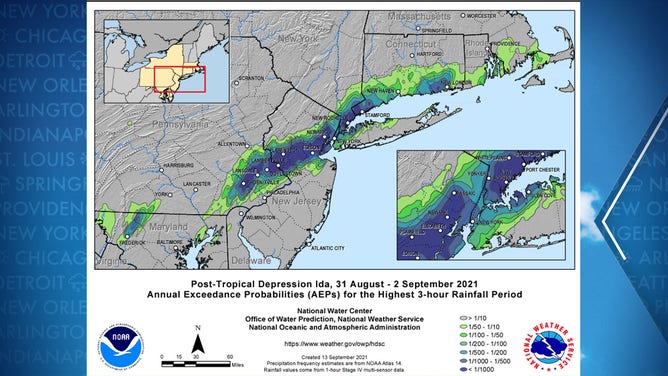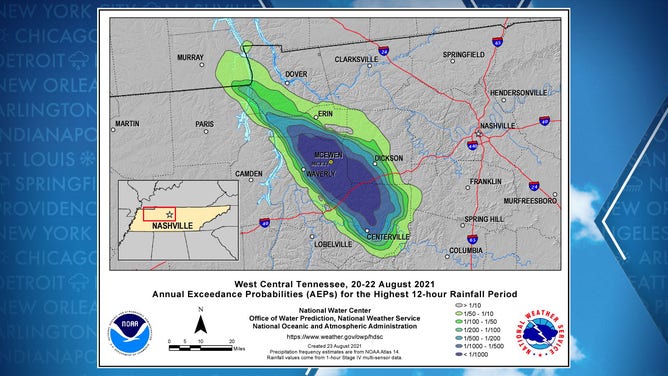Historic NYC-area Ida rainfall deemed as likely as once-in-millennium event
As the remnants of Hurricane Ida combined forces with a warm front pushing into New England, over three inches of rain fell in one hour at one point in New York City and Newark, New Jersey, smashing hourly rainfall records in both locations.
Historic NYC-area Ida rainfall deemed 1-in-1,000-year event
Over three inches of rain fell in one hour at one point in NYC and Newark, New Jersey, smashing hourly rainfall records in both locations.
NEW YORK -- The massive rain event on Sept. 1 that caused catastrophic flash flooding across parts of New York City, New Jersey and southeastern Pennsylvania has been deemed a probability akin to a once-in-a-millennium event, according to the National Weather Service's Office of Water Prediction.
As the remnants of Hurricane Ida combined forces with a warm front pushing into New England, over three inches of rain fell in one hour at one point in New York City and Newark, New Jersey, smashing hourly rainfall records in both locations. By the time the evening was done, over 7 inches of rain fell across New York City while Newark had measured 8.44 inches of rain.
The torrential rains quickly overwhelmed the region's drainage systems, leaving neighborhoods and roads flooded with water up to windows and higher on some roads.
Over 50 people died in the floods; many trapped in windowless basement units as water came pouring in.
Analysts with the Office of Water Prediction have pored over the rainfall data and have determined that the 3-hour rainfall collected on Sept. 1 across much of northern New Jersey, including Newark, Elizabeth and Passaic, and parts of the lower Hudson Valley area had a probability of 0.1% of happening in any given year.
Put another way, that means the likelihood of such an intense rainfall would be expected once every 1,000 years.
Similar fractional probabilities were found in rainfall rates across parts of southeastern Pennsylvania and central New Jersey.

Probability map for extreme rainfall event across New York, New Jersey and Pennsylvania
(NOAA / Office of Water Prediction)
For the Manhattan/New York City area, the rainfall was deemed about a 0.2% probability, or in essence, on par with a 1-in-500-year event.
Scientists note that it doesn’t mean storms of that magnitude could only happen once in a thousand years, just it's what would be expected based on the calculated probability. It is possible to have multiple floods of similar magnitude over a millennium. For example, rolling a '5' on a traditional six-sided die would only be expected once every six rolls but could happen more frequently in the real world.
Deadly Tennessee floods similarly low probability
This was the second extreme-low probability rainfall event of the summer in the Eastern U.S.
The heavy rainfall that caused catastrophic and deadly flooding across northwestern Tennessee in late August 14 inches of rain in 12 hours and 17 inches in less than 24 hours was also deemed to have a probability significantly less than 0.1 percent.

Probability map for extreme rainfall event across Tennessee on Aug. 20-22, 2021.
(NOAA / Office of Water Prediction)
Twenty people died in the event as the flood waters destroyed more than 270 homes.
